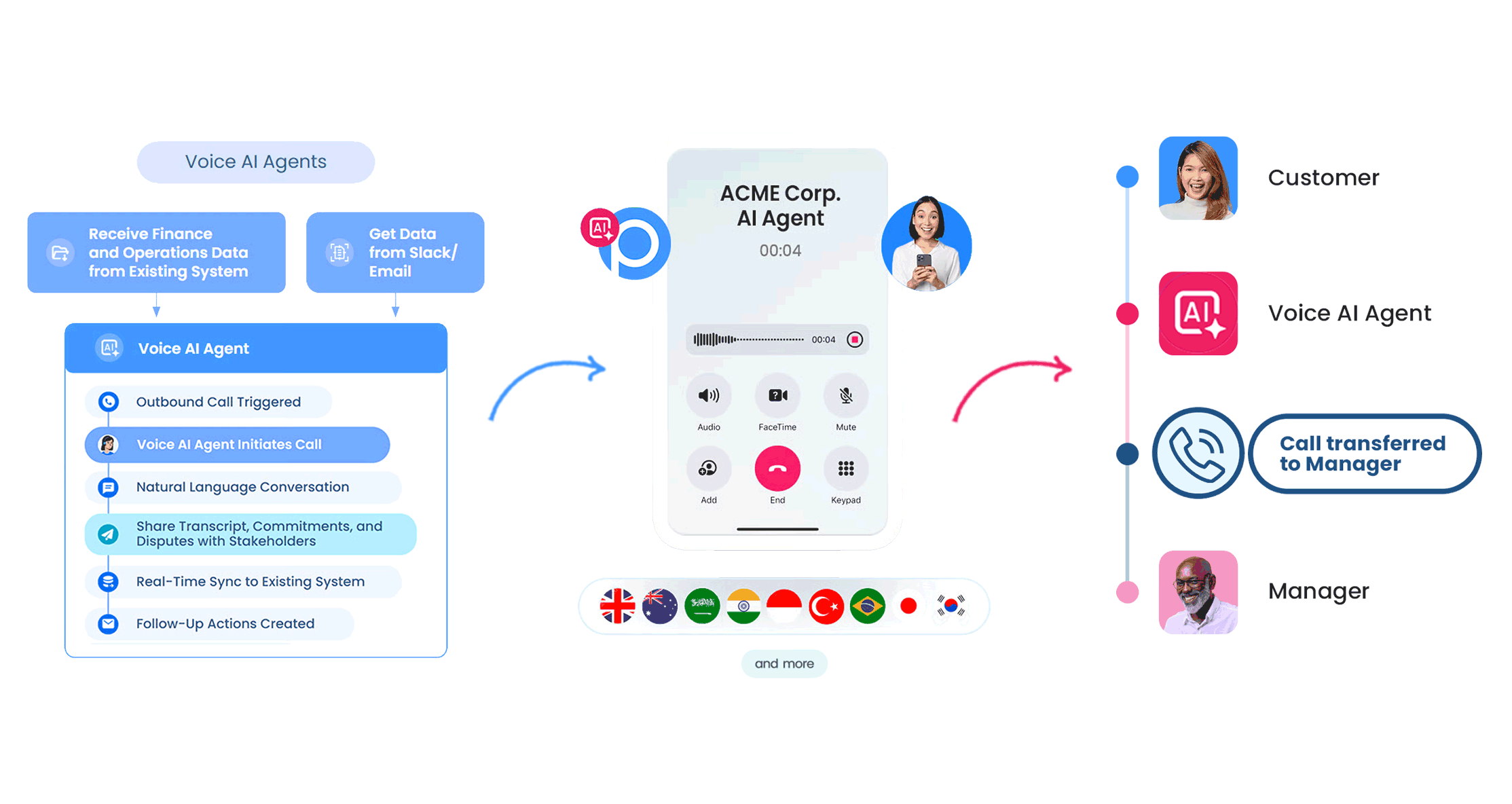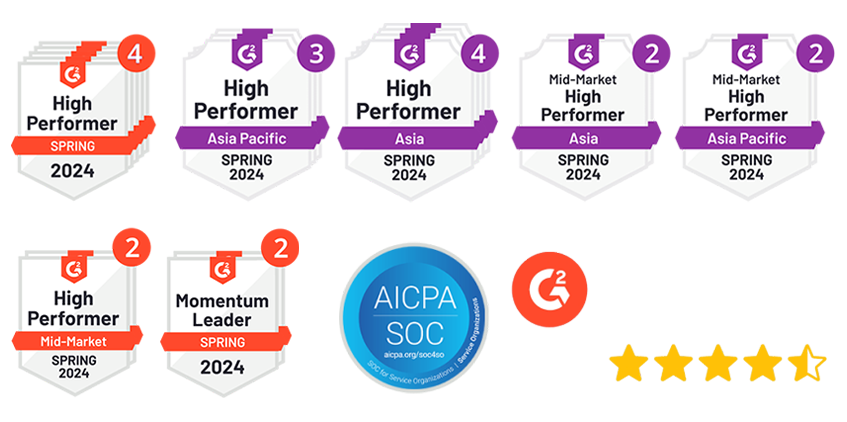Voice AI agents have become a significant force in business operations, with the market expected to reach $98.2 billion by 2027. These intelligent systems create seamless interactions between people and technology, offering capabilities that extend far beyond simple voice commands. Speech recognition technology alone is projected to reach $29.28 billion by 2026, indicating strong business adoption across industries.
What makes voice AI agents effective? These systems combine real-time speech recognition with advanced language models and natural-sounding voice synthesis. Voice-based AI agents streamline daily interactions by reducing the time needed to complete tasks. Voice-enabled AI agents also improve accessibility, allowing people with various abilities to interact with devices using speech alone.
Understanding voice AI agents and their applications is crucial for businesses looking to improve customer interactions and operational efficiency. This article will explore the technology behind voice AI agents, examine their current applications across industries, and discuss the trends shaping their development.
What is a Voice AI Agent?
A voice AI agent is a software system that processes spoken language and responds through speech to complete specific tasks or provide information. These agents combine automatic speech recognition (ASR), natural language understanding (NLU), and text-to-speech (TTS) technologies to deliver human-like conversational experiences. Modern voice AI agents can maintain context across multiple conversation turns, handle interruptions smoothly, and adjust their communication style based on user sentiment.
Definition and core concept
Voice AI agents operate as autonomous systems that receive input through microphones and respond through generated speech. They analyze spoken requests, determine the appropriate action, and provide relevant information using natural-sounding voices. These systems learn from each interaction, improving their accuracy and response quality over time.
The technology operates through a structured process where multiple components work together. Speech recognition converts audio signals into text, natural language processing interprets meaning and context, the system determines the correct response, and text-to-speech technology delivers the answer—all occurring within milliseconds.
How voice-based AI agents differ from chatbots
Traditional chatbots operate like automated phone systems, following predetermined decision trees and scripted responses. Voice AI agents function more like knowledgeable assistants who can adapt their approach based on the conversation’s direction.
The fundamental differences include:
- Voice agents use large language models (LLMs) to manage conversations naturally with minimal programming requirements
- They interpret user intent and match it with appropriate responses rather than following scripts
- Voice AI agents process information and adapt their responses, while chatbots simply execute programmed functions
- They manage complex workflows spanning multiple steps and provide specialized assistance across different business areas
Examples of voice-enabled AI agents in daily life
Voice-enabled AI assistants now handle a wide range of tasks in various settings. Common applications include:
- Personal assistants: Apple’s Siri, Google Assistant, Microsoft’s Cortana, and Amazon’s Alexa
- Customer service systems that resolve support requests, process transactions, and manage scheduling
- Healthcare applications for patient follow-ups, appointment coordination, and medication management
- Financial services handling account questions and payment processing
- Educational tools providing personalized instruction and language practice
These voice AI agents have streamlined many routine activities. Users can set appointments, check information, control connected devices, and access services through natural speech instead of typing or navigating through menus.
How Voice AI Agents Work Behind the Scenes
Voice AI agents operate through a sophisticated multi-step process that converts spoken words into meaningful actions. Understanding this process reveals how these systems manage real-time voice interactions with remarkable precision and speed.
Capturing and processing audio input
The process starts when your voice reaches the agent’s microphone. The system converts analog audio signals into digital format as the foundation for all subsequent processing steps. Specialized algorithms then extract relevant features from the signal using techniques like Fast Fourier Transform (FFT) or Mel-frequency cepstral coefficients (MFCCs). This extraction creates a spectrogram—a visual representation showing the speech signal’s frequency content over time.
Speech recognition and transcription
Automatic Speech Recognition (ASR) technology handles the conversion of processed audio into text. Modern ASR systems rely on end-to-end deep learning approaches, primarily using transformer-based architectures. These models can recognize multiple accents, filter background noise, and identify multiple speakers simultaneously. The technology has progressed from statistical models like hidden Markov models (HMMs) to advanced neural networks that deliver significantly higher accuracy.
Understanding intent with language models
Natural Language Understanding (NLU) interprets meaning and intent once speech becomes text. This component enables voice-based AI agents to identify the purpose behind user queries, extract key entities and relevant details, detect sentiment and emotional tone, and understand context across multi-turn conversations.
Large Language Models (LLMs) have changed this capability fundamentally. Traditional NLP systems primarily catch keywords like “billing” or “refund,” but LLM-based voice enabled AI agents can comprehend longer, more complex sentences. This allows users to speak naturally, as they would to another person.
Generating natural voice responses
Text-to-Speech (TTS) synthesis completes the process by converting the agent’s response into spoken language. Modern TTS systems incorporate elements like prosody (rhythm and melody), intonation (pitch variations), and stress patterns. These elements create natural-sounding voices that improve user engagement.
TTS systems use two main approaches: Unit Selection, which relies on pre-recorded speech segments, and Parametric Synthesis, which generates speech by converting phonemes into corresponding acoustic features. The output gets processed through a vocoder that synthesizes the final speech waveform, completing the cycle of how voice AI works.
This entire pipeline operates in near real-time, creating seamless conversations between humans and machines.
Types of Voice AI Agents in 2025
Voice AI agents serve different business purposes, and selecting the right type depends on your specific operational needs and complexity requirements. Each category offers distinct capabilities that address particular use cases and organizational objectives.
1. Rule-based voice agents
Rule-based systems operate through predefined “if-then” logic patterns that developers program manually. These agents handle repetitive, well-defined tasks where consistency matters more than flexibility. Their transparent decision-making process makes them suitable for applications requiring high auditability. Rule-based agents work well for businesses with standardized processes and limited variation in customer requests. However, they struggle with unexpected scenarios and require developer intervention for changes.
2. AI-assisted voice agents
AI-assisted agents understand natural language and maintain context across conversations. Users can ask follow-up questions without repeating information—if you inquire about tomorrow’s weather and then ask “And the day after?” the agent remembers your original question. These systems use Natural Language Processing (NLP) to interpret intent, creating more natural interactions than rule-based alternatives. They work effectively for businesses needing conversational flexibility while maintaining operational control.
3. Conversational voice agents
Conversational agents focus on natural dialogue and can understand tone, intent, and emotional context. They manage multi-step tasks seamlessly—helping customers reschedule a delivery, confirm changes, and handle follow-up questions in one continuous conversation. Large Language Models (LLMs) power these agents, making them particularly valuable in healthcare, hospitality, and finance, where personalized interactions drive customer satisfaction.
4. Voice-activated assistants
Voice-activated assistants like Siri, Alexa, Google Assistant, and Cortana handle daily tasks through voice commands. Research shows that 97% of smartphone users rely on these tools for routine activities, including playing music, setting alarms, and checking the weather. Recent improvements in generative AI have enhanced their ability to understand context and perform complex tasks. These assistants work best for general productivity and smart device integration.
5. Industry-specific voice agents
Specialized agents understand sector-specific terminology and workflows. Healthcare agents handle appointment scheduling while recognizing medical conditions and medications. Financial agents process banking terminology and complex transactions. Automotive voice assistants improve driving safety through hands-free operation. Major automakers, including Stellantis and Volkswagen, have integrated ChatGPT into their in-car systems for natural conversation during navigation and vehicle control.
Which type fits your business needs? Start by evaluating your interaction complexity, required flexibility, and industry-specific requirements. Simple, predictable tasks work well with rule-based systems, while complex customer service benefits from conversational agents.
Where Voice AI Agents Are Used Today
Voice AI agents have found practical applications across multiple industries, addressing specific operational challenges that businesses face daily. Organizations implement these systems to handle tasks that traditionally required human intervention, creating opportunities for cost reduction and improved customer experiences.
1. Customer service and support
Customer service departments struggle with high call volumes, long wait times, and the limitations of traditional phone systems. Voice AI agents solve these problems by providing immediate responses to customer inquiries without requiring customers to navigate complex menu systems.
These systems handle routine questions automatically, allowing human agents to focus on complex issues that require personal attention. Businesses implementing voice based AI agents can reduce contact center expenses by up to 40% while managing 90% of customer inquiries without human intervention. The transcribed interactions also provide valuable data about customer concerns, helping companies identify problems before they impact satisfaction scores.
2. Healthcare and patient engagement
Healthcare organizations face staffing constraints that make it difficult to maintain consistent patient communication. Voice AI agents address this challenge by conducting follow-up calls, health assessments, and appointment scheduling at scale.
Hospitals like Cedars-Sinai have seen call volume drop by half while maintaining 94% user satisfaction after implementing voice AI systems. For patients dealing with anxiety or health concerns, these systems provide 24/7 support when medical staff aren’t available, ensuring continuous care without increasing staffing costs.
3. Retail and personal shopping
Retail businesses are adapting to changing consumer preferences for convenient, hands-free shopping experiences. Voice commerce allows customers to make purchases while multitasking, addressing the demand for more efficient shopping methods.
The numbers show strong adoption: 30.4% of Gen Z consumers shop by voice weekly, and voice commerce transactions in the United States grew by 321.74% from 2021 to 2023, increasing from $4.60 billion to $19.40 billion. This growth reflects both consumer acceptance and the practical benefits of voice-enabled purchasing.
4. Finance and banking
Financial institutions handle sensitive calls involving fraud detection, payment processing, and account disputes that require both accuracy and appropriate customer interaction. Voice AI agents manage these high-stakes conversations while maintaining security protocols and providing personalized service.
Banks implementing voice AI systems typically see improvements in call resolution rates, reduced wait times, and higher customer satisfaction scores. The technology allows financial institutions to provide consistent service quality while reducing the operational complexity of managing large call volumes.
5. Education and language learning
Educational institutions seek ways to provide personalized learning experiences while accommodating students with different needs and abilities. Voice AI creates more accessible learning environments, particularly for language acquisition where immediate feedback on pronunciation and conversation practice proves valuable.
Students with learning differences or physical limitations benefit from voice-enabled learning tools that remove traditional barriers to educational participation. These systems provide consistent, patient instruction that adapts to individual learning paces and styles.
Benefits of Using Voice AI Agents
Voice AI agents deliver measurable business advantages that explain their growing adoption across different industries.
1. Faster response times and 24/7 availability
Voice-enabled AI agents eliminate wait times completely, providing instant responses that improve customer satisfaction. With GPT-4o reducing latency to just 232 milliseconds for audio inputs, these systems maintain natural conversation flow. They operate around the clock without staffing costs or overtime expenses, ensuring customers receive support regardless of time zones or business hours.
2. Cost savings and operational efficiency
Businesses implementing voice based AI agents report operational cost reductions of 30-40%. Banking institutions have achieved even better results—up to 70% cost reduction while improving customer satisfaction. These savings come from voice agents handling 60-80% of routine inquiries without human intervention.
3. Improved accessibility for users with disabilities
For the 61 million American adults living with disabilities, how voice AI works creates new access opportunities. People with visual impairments benefit from screen readers that interpret text, while those with hearing limitations use tools like Google Live Transcribe. Mobility-restricted individuals gain hands-free navigation through voice commands.
4. Personalized and contextual interactions
Voice AI agents can interpret tone, sentiment, and intent, creating tailored experiences that build customer loyalty. They access customer history to personalize responses, which explains why 73% of consumers are more likely to purchase again from companies offering personalized service.
5. Data collection for better decision-making
Each interaction generates insights into customer behavior patterns and sentiment, allowing businesses to identify trends and improve products based on direct user feedback.
Future Trends in Voice AI Technology
Voice AI technology continues to evolve rapidly, with several key developments expected to change how businesses and users interact with these systems. These advances build on the foundation of current voice AI capabilities while addressing existing limitations.
1. Emotion-aware voice agents
Voice AI systems are developing the ability to recognize and respond to emotional states beyond simple word recognition. Research has identified key acoustic indicators like root mean square, zero-crossing rate, and jitter as sensitive to emotions. These systems will favor neutral or positive responses when engaging with negative emotional cues, mirroring human emotional regulation patterns. However, these advancements face challenges in handling cultural differences and environmental factors.
This capability allows voice agents to adjust their responses based on a user’s emotional state, potentially improving customer service interactions and creating more empathetic user experiences.
2. Edge computing for faster responses
Edge technology processes data where it’s created rather than sending it to remote servers, dramatically reducing response time. This approach enables voice enabled AI agents to function with extremely low power consumption—less than a milliampere of current. Edge computing ensures privacy as audio processing happens on-device, making it ideal for healthcare and financial applications.
For businesses, edge computing means voice AI agents can operate more efficiently while maintaining data security and reducing dependency on internet connectivity.
3. Long-term memory for personalized experiences
Microsoft executives predict AI assistants with “really good long-term memory” will arrive within a year. These systems will store conversation history, preferences, and personal details to create truly personalized interactions. This memory allows continuous learning and self-improvement, surpassing the limitations of traditional context windows.
Long-term memory capabilities enable voice agents to build relationships with users over time, remembering preferences and past interactions to provide increasingly relevant assistance.
4. Voice customization and dynamic tone
Advanced voice design now enables creating unique voices from prompts or recordings as short as 5 seconds. Users can adjust gender, age, accent, vocal register, and emotional intonation for precise customization. This technology allows voice based AI agents to adapt their tone based on context and user preferences.
Voice customization gives businesses the ability to create distinctive brand voices and allows users to interact with AI systems that sound more familiar and comfortable to them.
5. Advanced orchestration for complex tasks
Complex task management represents the next step in voice AI development. Orchestration systems will enable agents to collaborate, solving intricate problems through coordinated efforts between multiple AI systems.
This advancement will allow voice AI agents to handle multi-step business processes that currently require human oversight, potentially automating more complex workflows across different departments and systems.
How Peakflo’s Voice AI Agents Power Your Business Processes
Peakflo AI Voice Agents are purpose-built to simplify finance operations—no manual calls, no swivel-chairing between tools. Whether it’s chasing down late payments, confirming invoices, or updating customers with real-time status, our AI agents handle it all with natural, human-like conversations.
Powered by advanced speech recognition, contextual understanding, and dynamic voice synthesis, Peakflo’s voice agents integrate seamlessly with your ERP and CRM systems. They don’t just talk—they listen, learn, and take action. Need a payment reminder sent? Done. Want an update logged back into NetSuite or Salesforce? Handled automatically.

With Peakflo, teams reduce call handling time by up to 70%, improve cash flow, and ensure every conversation is consistent and compliant. No scripts. Just results.
Ready to automate your calls? Get started today.
A Way Forward
Voice AI agents have moved from experimental technology to practical business tools that address real operational challenges. Understanding how these systems work—from speech recognition through natural language processing to voice synthesis—helps businesses make informed implementation decisions.
The applications across customer service, healthcare, retail, finance, and education demonstrate voice AI’s versatility in solving specific business problems. For businesses considering voice AI implementation, start by evaluating your current customer interaction challenges. Look for repetitive tasks, high call volumes, or accessibility gaps where voice AI can provide immediate value. Focus on specific problems rather than broad digital strategies.
Voice AI technology has proven its effectiveness across industries. The question for most organizations is not whether to adopt voice AI, but how to implement it strategically to address their specific operational needs and customer requirements.
FAQs
Q1. What advancements can we expect in voice AI technology by 2025?
By 2025, voice AI is expected to become more emotion-aware, with faster response times due to edge computing. We’ll also see AI assistants with improved long-term memory, customizable voices, and the ability to handle complex tasks through advanced orchestration.
Q2. How are voice AI agents different from traditional chatbots?
Voice AI agents are more sophisticated than traditional chatbots. They use large language models to understand context, adapt to conversations, and engage in more natural, human-like interactions. Unlike chatbots that follow scripts, voice AI agents can handle complex workflows and provide personalized assistance across various domains.
Q3. In which industries are voice AI agents commonly used?
Voice AI agents are widely used in customer service, healthcare, retail, finance, and education. They handle tasks such as answering customer queries, conducting health risk assessments, facilitating voice commerce, processing financial transactions, and providing personalized learning experiences.
Q4. What are the main benefits of implementing voice AI agents for businesses?
Implementing voice AI agents can lead to faster response times, 24/7 availability, significant cost savings, improved operational efficiency, and better data collection for decision-making. They also enhance accessibility for users with disabilities and provide personalized interactions, improving customer satisfaction and loyalty.
Q5. How does voice AI technology work behind the scenes?
Voice AI technology works through a multi-step process. It starts with capturing and processing audio input, then uses speech recognition to convert speech to text. Natural language processing interprets the meaning and intent, and finally, text-to-speech technology generates a spoken response. This entire process happens in near real-time, enabling seamless conversations.










![Why AI Sales Calls Are Making Good Sales Reps Even Better [2025 Guide] ai sales calls](https://blog.peakflo.co/wp-content/uploads/2025/09/65168cf6-3001-4733-8cbc-12d5684cf449-218x150.webp)


































